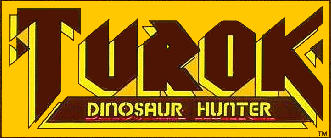Turok, Son of Stone
| Turok | |
|---|---|

Logo of the Turok comic series
|
|
| Publication information | |
| Publisher | Western Publishing, Dell Comics |
| First appearance | Four Color Comics #596 (October/November 1954) |
| In-story information | |
| Species | Human |
| Place of origin | Earth |
| Abilities |
|
Turok is a fictional American comic book character that first appeared in books published by Western Publishing through licensee Dell Comics. He first appeared in Four Color Comics #596 (October/November 1954). After a second Four Color appearance (#656 October 1955), the character graduated to his own title – Turok, Son of Stone (#3 March–May 1956) — published by both Dell and then Gold Key Comics from 1956 to 1982. Subsequently, he appeared in titles published by Valiant Comics, Dark Horse Comics and Dynamite Comics.
The character also inspired a popular video game series, starting with Turok: Dinosaur Hunter, published by Acclaim Entertainment in 1997. Several sequels would be released in the following years for various gaming consoles.
The original comic, titled Turok, Son of Stone, was illustrated by Rex Maxon. The writer-creator credit for the characters of Turok and Andar is disputed, with historians citing Matthew H. Murphy, Gaylord Du Bois and Paul S. Newman as the feature's earliest writers.
The Western Publishing version of Turok was a pre-Columbian Native American (identified as Mandan in the first issue, on page 21 and 32 of Dell Four Color #596) who, along with his brother, Andar, became trapped in an isolated canyon valley populated by dinosaurs, which they refer to in general as "hoppers", "monsters" and more often than not, beginning in Dell issue number 9, page 35 as "honkers", as well as by their most obvious characteristics (tyrannosaurs are called "runners", pterosaurs are called "flyers", velociraptors are "screamers", plesiosaurs are "sea demons", Triceratops are "rammers", etc.). The Du Bois stories involve Turok and Andar seeking a way out of the canyon. Du Bois was influenced by his visits to Carlsbad Caverns, New Mexico and developed the "Lost Valley" from his visits to the area.
...
Wikipedia
